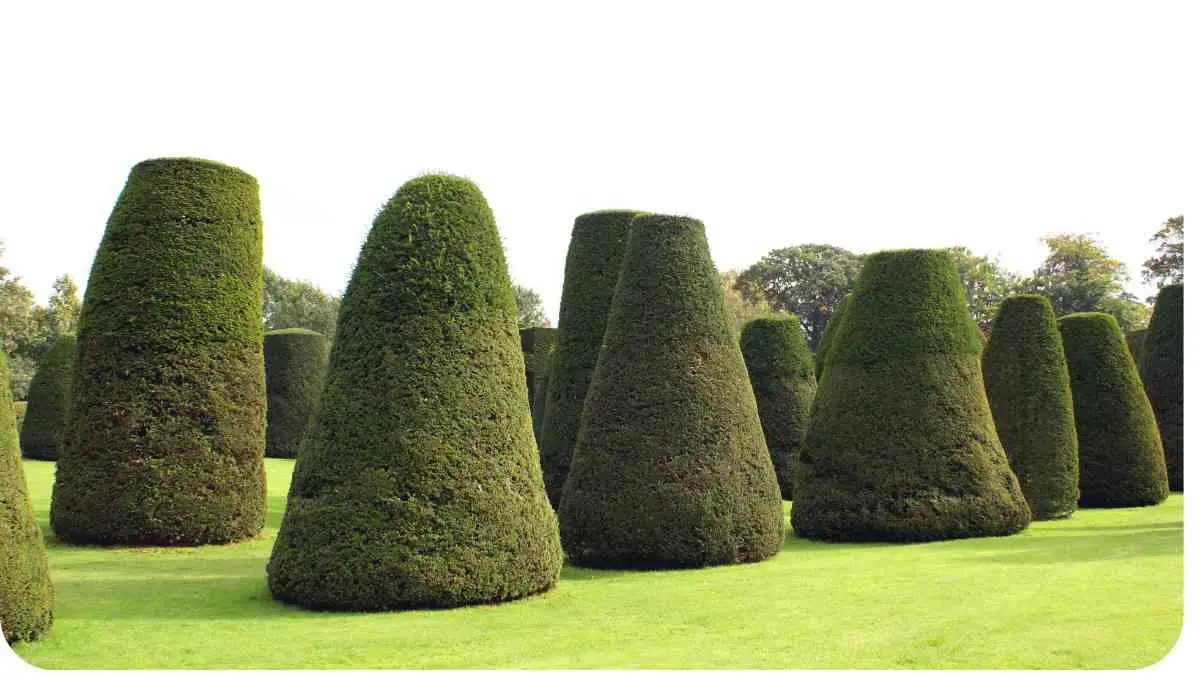Topiaries are living works of art, transforming ordinary bushes into intricate, eye-catching shapes. But keeping them in prime condition can be a real challenge. Ever wondered why your topiary isn’t holding its shape or seems to be struggling?
You’re not alone. In this article, we’ll dive into the common issues you might face with topiaries, from overgrowth to pest problems, and provide you with practical tips to keep your topiary in perfect shape.
| Takeaway |
|---|
| Regular pruning is crucial to maintain the shape of your topiary and prevent overgrowth. |
| Uneven growth can be managed by ensuring balanced sunlight and nutrients. |
| Pests and diseases should be addressed promptly with appropriate treatments. |
| Seasonal care varies: water and fertilize more in spring and summer, and reduce care in autumn and winter. |
| Choosing the right plants and fertilizers is key to a healthy topiary. |
| DIY projects can be cost-effective, but hiring a professional may be necessary for complex shapes or large topiaries. |
| Budgeting for tools, fertilizers, and maintenance helps manage costs effectively. |
What Are Topiaries?

Topiaries are plants that have been shaped into geometric forms, animals, or other designs through careful pruning and training. They can range from simple spheres to elaborate animal shapes, adding a touch of elegance to any garden. But shaping and maintaining these living sculptures requires more than just basic gardening skills.
Pruning is essential for plant health, but overdoing it can lead to damage. If you’re struggling with maintaining your topiaries, you might find recovery tips for over-pruned shrubs helpful to restore their shape and vitality.
Why Topiary Maintenance Is Important
Maintaining topiaries isn’t just about aesthetics it’s crucial for the health of the plants. Regular maintenance ensures that your topiaries remain vibrant and well-formed, preventing common problems such as uneven growth and disease. Plus, a well-maintained topiary can be a centerpiece that adds value and charm to your garden.
Common Issues with Topiary Shapes
Overgrown Topiaries
Overgrown topiaries can quickly lose their shape and become unruly. This usually happens when regular pruning is neglected, causing the plant to grow wildly and unevenly. To prevent this, a consistent pruning schedule is essential.
| Issue | Description | Solution |
|---|---|---|
| Overgrowth | Excessive, uncontrolled growth | Regular pruning and shaping |
| Causes | Lack of pruning, rapid growth | Implement a strict pruning routine |
Uneven Growth
Uneven growth in topiaries can result in lopsided shapes or gaps in the design. This issue often arises when the plant receives uneven sunlight or nutrients. Proper care and attention to the plant’s environment can help address this issue.
When topiaries or hedges grow unevenly, nutrient imbalances are often to blame. For those battling this issue, consider learning about addressing nutrient imbalances in hedges to ensure even and healthy growth.
| Issue | Description | Solution |
|---|---|---|
| Uneven Growth | Lopsided or gaps in shape | Adjust sunlight and nutrient distribution |
| Causes | Uneven sunlight, poor nutrition | Ensure balanced growth conditions |
Pest Infestation
Pests like aphids and spider mites can wreak havoc on topiaries, causing damage that distorts their shape. Regular inspection and timely treatment can help control these pests and prevent further damage.
| Pest | Description | Treatment |
|---|---|---|
| Aphids | Small, sap-sucking insects | Use insecticidal soap or neem oil |
| Spider Mites | Tiny, web-spinning pests | Apply miticides or insecticidal soap |
Disease Problems
Diseases such as fungal infections can cause leaves to wilt and distort, affecting the overall appearance of your topiary. Identifying and treating diseases early is key to maintaining a healthy topiary.
| Disease | Symptoms | Treatment |
|---|---|---|
| Fungal Infections | Wilting leaves, discoloration | Apply fungicides and improve air circulation |
| Bacterial Blight | Dark spots, leaf drop | Remove infected leaves and use bactericides |
Effective Pruning Techniques

Tools You’ll Need
Proper pruning tools are essential for maintaining the shape of your topiary. Invest in high-quality shears and clippers to make the task easier and more effective.
Stunted growth is a common concern when managing topiaries, just like with raised beds. If you’ve noticed slow or uneven growth, troubleshooting stunted growth can offer practical solutions for healthier plants.
| Tool | Purpose | Recommended Type |
|---|---|---|
| Pruning Shears | Shaping and trimming | Bypass shears for clean cuts |
| Hedge Clippers | Large-scale pruning | Long-blade clippers for efficiency |
Step-by-Step Guide
- Assess the Topiary: Determine which areas need shaping and which branches to trim.
- Start with the Base: Work from the bottom up, ensuring a uniform shape.
- Shape Gradually: Make small, gradual cuts to avoid removing too much foliage at once.
- Regular Touch-Ups: Perform minor adjustments regularly to maintain the shape.
Dealing with Pests and Diseases
Common Pests
Understanding the common pests that affect topiaries can help you take preventive measures.
| Pest | Description | Control Measures |
|---|---|---|
| Aphids | Small, sap-sucking insects | Use insecticidal soap |
| Spider Mites | Tiny, web-spinning pests | Apply miticides |
Managing Diseases
Diseases can be challenging to manage, but early intervention is crucial.
| Disease | Symptoms | Treatment |
|---|---|---|
| Powdery Mildew | White, powdery substance | Use fungicides and improve air flow |
| Root Rot | Mushy roots, yellowing leaves | Improve drainage and reduce watering |
Seasonal Care Tips
Spring and Summer Care
During the warmer months, topiaries require regular watering and fertilization to thrive.
| Task | Description | Frequency |
|---|---|---|
| Watering | Ensure soil remains moist | Twice a week or as needed |
| Fertilization | Provide essential nutrients | Monthly during the growing season |
Autumn and Winter Care
In cooler months, reduce watering and avoid fertilizing to prevent stress on the plant.
| Task | Description | Frequency |
|---|---|---|
| Watering | Water less frequently | As needed based on weather |
| Pruning | Avoid heavy pruning | Only remove dead or diseased branches |
Choosing the Right Plants for Topiaries

Popular Topiary Plants
Some plants are better suited for topiary than others due to their growth habits and leaf structure.
Stunted growth is a common concern when managing topiaries, just like with raised beds. If you’ve noticed slow or uneven growth, troubleshooting stunted growth can offer practical solutions for healthier plants.
| Plant | Characteristics | Best Use |
|---|---|---|
| Boxwood | Dense foliage, slow growth | Ideal for detailed shapes |
| Yew | Flexible branches, dense growth | Good for classic topiary forms |
Plant Characteristics to Consider
When selecting plants, consider their growth rate, leaf structure, and maintenance needs.
| Characteristic | Importance | Examples |
|---|---|---|
| Growth Rate | Affects shaping frequency | Boxwood, Yew |
| Leaf Structure | Influences the final appearance | Holly, Privet |
The Role of Fertilization in Topiary Health
Types of Fertilizers
Choosing the right fertilizer can make a significant difference in the health and appearance of your topiary.
| Type | Description | Application |
|---|---|---|
| Balanced Fertilizer | Equal N-P-K ratio | Apply every 6-8 weeks |
| Slow-Release Fertilizer | Gradual nutrient release | Apply every 3-4 months |
Application Methods
Proper application ensures that the nutrients are effectively absorbed by the plant.
| Method | Description | Pros |
|---|---|---|
| Granular Fertilizer | Spread on soil surface | Easy to apply |
| Liquid Fertilizer | Mixed with water and applied | Faster nutrient uptake |
DIY Topiary Projects
Creating Your Own Topiary Frames
Building your own frames can be a fun and cost-effective way to start topiary gardening.
| Material | Purpose | Tips |
|---|---|---|
| Wire Frames | Structure for shaping | Use sturdy wire for durability |
| Moss | Base for planting | Keep moist to support plant roots |
Design Ideas and Inspiration
Explore creative designs to make your topiary unique.
| Design | Description | Ideas |
|---|---|---|
| Classic Shapes | Geometric forms like spheres and cones | Use for formal gardens |
| Animal Shapes | Animals like rabbits and birds | Add whimsy to your garden |
Hiring a Professional Topiary Specialist
When to Seek Professional Help
Sometimes, a professional touch is needed to address complex topiary issues or for large-scale projects.
| Scenario | Reason | Solution |
|---|---|---|
| Complex Shapes | Difficult to maintain on your own | Hire a specialist for precision work |
| Large Topiaries | Requires specialized equipment | Professional services for efficiency |
What to Look for in a Specialist
Finding the right specialist ensures quality work and proper care for your topiaries.
| Trait | Importance | Tips |
|---|---|---|
| Experience | Ensures expertise | Look for proven track record |
| References | Provides reliability | Check client reviews and previous work |
Budgeting for Topiary Maintenance
Cost Breakdown
Understanding the costs associated with topiary maintenance helps in planning and budgeting.
Yellowing leaves can indicate underlying issues that affect topiaries as well. To pinpoint the cause of this problem, check out how to solve yellowing leaves and take steps to revitalize your plants.
| Item | Cost | Notes |
|---|---|---|
| Tools | $50-$200 | Invest in quality tools |
| Fertilizers | $20-$60 per application | Choose based on plant needs |
Saving Tips
Budgeting doesn’t have to break the bank use these tips to save money on topiary maintenance.
| Tip | Description |
|---|---|
| DIY Maintenance | Perform basic maintenance yourself |
| Buy in Bulk | Purchase supplies in bulk to reduce costs |
Topiary Care FAQs
What is the best time to prune topiaries?
Pruning is typically best done in late winter or early spring before new growth begins.
How often should I fertilize my topiary?
Fertilize your topiary every 6-8 weeks during the growing season for optimal health.
How can I prevent pest infestations?
Regular inspections and timely treatments with appropriate insecticides can help prevent pests.
What are the signs of a diseased topiary?
Look for wilted leaves, unusual discoloration, or fungal growth as signs of disease.
Can I shape my topiary into any form?
Yes, with the right techniques and care, topiaries can be shaped into a variety of forms from geometric to whimsical designs.
Conclusion
Maintaining topiaries involves a blend of art and science. From dealing with common issues like overgrowth and pests to mastering pruning techniques, keeping your topiary in shape requires regular attention and care. With the tips and insights provided, you’ll be well-equipped to tackle any challenges and enjoy the beauty of your perfectly sculpted topiary.
Further Reading
Topiary Shapes: The Best Ones to Try
This guide explores various topiary shapes you can try in your garden, offering inspiration and practical advice for creating stunning designs.
Caring for Your Topiary
Discover essential tips and techniques for maintaining your topiary’s health and appearance, from pruning to pest control.
Topiary: A Complete Gardening Guide
A comprehensive guide on topiary gardening, including plant selection, shaping methods, and maintenance tips for thriving topiaries.
Topiary Care FAQs
What is the best time to prune topiaries?
Pruning is most effective in late winter or early spring when the plant is dormant and new growth is about to begin.
How often should I water my topiary?
Watering frequency depends on the climate and type of plant. Generally, keep the soil moist but not waterlogged, and adjust based on seasonal needs.
What should I do if my topiary is showing signs of disease?
Identify the symptoms first, then apply appropriate treatments such as fungicides for fungal infections or improving air circulation to prevent disease spread.
How can I prevent pests from damaging my topiary?
Regularly inspect your topiary for pests and use preventive measures such as insecticidal soap or natural predators to keep infestations at bay.
Can I shape my topiary into custom designs?
Absolutely! With the right techniques and care, you can shape your topiary into a wide range of designs, from classic geometric forms to whimsical figures.

Hi! My name is Hellen James, and I’m a landscape designer in Los Angeles. I’ve been working with homeowners and businesses to help them improve the look of their properties for over 10 years.

